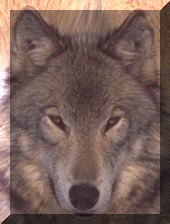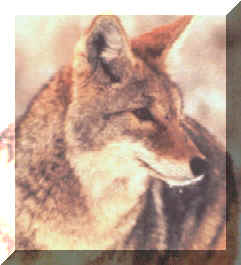


Gray Wolf
Status: Endangered in all lower 48 states except
Minnesota, where it is threatened.
Description: Largest member of the canine family and an
ancestor of the dog. Typical color is tan, or a grizzled gray and black; although some
wolves are all-black or all-white.
Size: Height: 26-32 inches at the shoulder. Weight:
55-115 pounds. Females are usually slightly smaller.
Habitat: Forests, tundra, deserts, plains and
mountains.
Range: North America (Minnesota and Canada); small
areas in Europe, Asia and the Middle East.
Food Source: Large, hoofed mammals such as deer and
elk, and occasionally smaller animals (beaver or rabbit). Wolves kill animals that are the
easiest to capture--young, old, diseased or deformed ones--but will kill healthy adult
animals if the opportunity arises.
Behavior: Wolves live in packs, which are complex
social structures that include the breeding adult pair (the alpha male and female) and
their offspring. Size of the pack varies with the size of available prey. Packs that feed
on deer may average only 3-6 animals, while those preying on moose can be as large as 15.
A hierarchy of dominant and subordinate animals within the pack help it to function as a
unit. Wolves communicate with fellow pack-mates and other wolf packs by scent marking,
vocalizations, facial and body postures. Also use barks, whimpers, growls and howls to
express themselves.
Howling: Howling is an important and effective way to
send long distant messages to other wolves. It serves to find individuals that get
separated from the rest of the pack; define territory, defend a fresh kill, and assemble
the pack. Pups begin to howl at one month old.
Reproduction: Wolves mate in February or March. Females
give birth two months later to a litter of pups. An average litter is four to seven pups.
Litter size and pup mortality depend on food supply, weather and the health of the mother.
Survival Threats: Human encroachment into wolf
territory. Wolves need open land and an abundant supply of prey to survive. The illegal
killing of wolves is a serious problem, especially for small populations. Almost
one-quarter of the wolves in Minnesota are illegally killed each year.
Legal Protection: CITES, Appendix I (populations of
Bhutan, India, Nepal and Pakistan); Appendix II (all other populations). Endangered
Species Act
